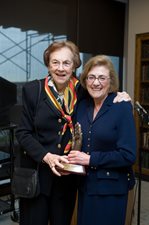Girls Don't Do That
When Carol Cooperman Nadelson (MD ’61) was a 12-year old girl growing up in Brooklyn during the 1940s, she had a favorite spot to go after school. She would drop off her books at her family’s Flatbush home and follow the sidewalk to her grandfather’s house.

Dr. Cooperman Nadelson, circa 1970
She spent hours beside him, reading aloud and talking. But her grandfather had cancer and, as months passed, she saw his pain increase and watched his body weaken. Finally, though her parents were of a generation that did not openly discuss death and dying with children, she knew the afternoon visits were over.
“That’s when I decided I was going to be a doctor, even though girls didn’t do that,” Nadelson says.
In the beginning, Nadelson’s parents casually dismissed her unorthodox plan. While today’s Gallup polls show Americans think “being a doctor” is one of the best career choices a woman can make, virtually no one in the country recommended it for women in a 1953 poll. Like most other girls, she faced a fairly predictable future as a nurse, teacher, or secretary. Yet Nadelson, with a well-worn biography of Marie Curie on her bookshelf, and an open-minded uncle standing behind her, persevered. Upon graduation from high school, she enrolled as a pre-med student at Brooklyn College.
While she would occasionally spot another woman on campus, Nadelson was usually the only female student in her advanced level courses. She would slide into the back row of lecture halls, but some professors would still find her. They questioned her more often than her classmates, or worse, they sexually harassed her.
“There wasn’t a word for it then, and I never told my parents,” Nadelson says. “It was not a comfortable experience.”
Even so, Nadelson excelled, becoming the first woman president of the college’s Bio-Med Society. After being inducted into Phi Beta Kappa and graduating magna cum laude, she sent applications to two dozen medical schools, including the U of R. It was during a time when medical schools were “experimenting” with the notion of admitting women; usually only a handful of women were allowed into each class.
At first, not a single school accepted her.
But as women’s suffragist Susan B. Anthony -- one of Rochester’s most famous residents -- once said, “Failure is impossible.” Anthony, who was instrumental in opening the U of R to women, would undoubtedly have been pleased when a determined Nadelson persuaded one school to take her the following year. Fittingly, it was Rochester.
“There was still prejudice, but I also found many supportive people who were apologetic,” Nadelson recalls. “I had an incredibly good experience there.”
That experience included two mentors whose names, even today, are often spoken as if preceded by a silent “Sir”: the late John Romano, M.D., and George Engel, M.D. (Their international contributions to the field of psychiatry and medical education would surely have earned them knighthood had they come from across the pond.) As they were helping shape modern psychiatry, Nadelson’s future came into focus too.
“All through medical school, I didn’t think I was going to go into psychiatry, but those two were persistent,” says Nadelson, who – after being the only woman intern at Strong Memorial Hospital -- ended up completing residencies in Psychiatry at Massachusetts Mental Health Center and Beth Israel Hospital, and informally introducing the biopsychosocial model to her colleagues. “That theory was born in Rochester, and it was a new idea when I got to Boston.”

Dr. Cooperman Nadelson with her family
After beginning to establish herself in academic medicine at Harvard University, Nadelson started another line of work: advocate and mentor for women in medicine. This became a 50-year commitment to chairing admissions, diversity, and harassment policy committees; leading women’s mentoring projects; and participating in countless women’s leadership and career advancement activities. In 1985, the American Medical Women’s Association awarded her the Elizabeth Blackwell Medal, recognizing her outstanding contributions to women in medicine. In 1998, she was recruited as director of the Partners Office for Women’s Careers at Brigham and Women’s Hospital, and developed a formal mentoring program for women and minorities that was adopted by other Harvard Medical School affiliates.

Dr. Cooperman Nadelson receiving the Renaissance Woman Award
As she devoted herself to aiding other women, her own career flourished. She became first woman elected president of the American Psychiatric Association. First woman editor in chief of the American Psychiatric Press. A founding member and president of the Association for Academic Psychiatry. She co-edited The Woman Patient: Medical and Psychiatric Interfaces, landmark volumes that introduced the field of women’s mental health. Her clinical work and research changed the way victims of abuse and rape are treated. In 2003, when the National Library of Medicine presented Changing the Face of Medicine, a traveling exhibit honoring female pioneers, Nadelson’s extraordinary story was told at universities and public libraries across the nation.
Click here to look at Nadelson's inspiring story on the Changing the Face of Medicine web site.
Nadelson remains a full professor at Harvard Medical School, and continues to devote much of her time to mentoring residents, fellows, and junior faculty. She even sees a few patients.

Dr. Cooperman Nadelon’s grandchildren
But today, she is at her son’s home in New Jersey, getting ready to construct a house, or perhaps a castle, out of blocks with her grandchildren, ages one and two and a half. They are the youngest of Nadelson’s four grandchildren, who are growing up in a very different world for women in medicine; a world their grandmother helped build.
“It is incredibly gratifying to look back and see how much has changed since I went to medical school,” Nadelson says.
Between 1932 - 1960, SMD admitted an average of fewer than four women into each class. This year, more than half of Rochester's first-year medical students were women.

